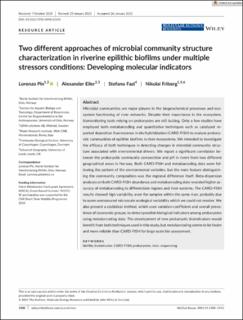| dc.contributor.author | Pin, Lorenzo | |
| dc.contributor.author | Eiler, Alexander | |
| dc.contributor.author | Fazi, Stefano | |
| dc.contributor.author | Friberg, Nikolai | |
| dc.date.accessioned | 2021-07-16T10:01:39Z | |
| dc.date.available | 2021-07-16T10:01:39Z | |
| dc.date.created | 2021-03-11T10:54:19Z | |
| dc.date.issued | 2021 | |
| dc.identifier.citation | Molecular Ecology Resources. 2021, 21 (4), 1200-1215. | en_US |
| dc.identifier.issn | 1755-098X | |
| dc.identifier.uri | https://hdl.handle.net/11250/2764646 | |
| dc.description.abstract | Microbial communities are major players in the biogeochemical processes and ecosystem functioning of river networks. Despite their importance in the ecosystem, biomonitoring tools relying on prokaryotes are still lacking. Only a few studies have employed both metabarcoding and quantitative techniques such as catalysed reported deposition fluorescence in situ hybridization (CARD‐FISH) to analyse prokaryotic communities of epilithic biofilms in river ecosystems. We intended to investigate the efficacy of both techniques in detecting changes in microbial community structure associated with environmental drivers. We report a significant correlation between the prokaryotic community composition and pH in rivers from two different geographical areas in Norway. Both CARD‐FISH and metabarcoding data were following the pattern of the environmental variables, but the main feature distinguishing the community composition was the regional difference itself. Beta‐dispersion analyses on both CARD‐FISH abundance and metabarcoding data revealed higher accuracy of metabarcoding to differentiate regions and river systems. The CARD‐FISH results showed high variability, even for samples within the same river, probably due to some unmeasured microscale ecological variability which we could not resolve. We also present a statistical method, which uses variation coefficient and overall prevalence of taxonomic groups, to detect possible biological indicators among prokaryotes using metabarcoding data. The development of new prokaryotic bioindicators would benefit from both techniques used in this study, but metabarcoding seems to be faster and more reliable than CARD‐FISH for large scale bio‐assessment. | en_US |
| dc.language.iso | eng | en_US |
| dc.rights | Navngivelse 4.0 Internasjonal | * |
| dc.rights.uri | http://creativecommons.org/licenses/by/4.0/deed.no | * |
| dc.title | Two different approaches of microbial community structure characterization in riverine epilithic biofilms under multiple stressors conditions: Developing molecular indicators | en_US |
| dc.type | Peer reviewed | en_US |
| dc.type | Journal article | en_US |
| dc.description.version | publishedVersion | en_US |
| dc.rights.holder | © 2021 The Authors. | en_US |
| dc.source.pagenumber | 1200-1215 | en_US |
| dc.source.volume | 21 | en_US |
| dc.source.journal | Molecular Ecology Resources | en_US |
| dc.source.issue | 4 | en_US |
| dc.identifier.doi | 10.1111/1755-0998.13341 | |
| dc.identifier.cristin | 1897236 | |
| dc.relation.project | EU/765553 | en_US |
| cristin.ispublished | true | |
| cristin.fulltext | original | |
| cristin.qualitycode | 1 | |

